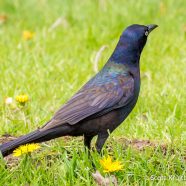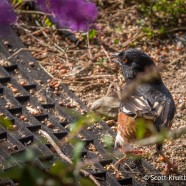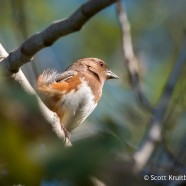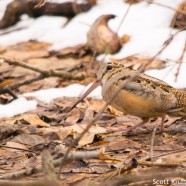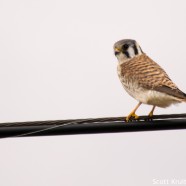Common Grackle
This Common Grackle (Quiscalus quiscula) was in search of some snacks, using those big yellow eyes to scope out prey in the grass. They will eat nearly anything and everything which is part of why we see them everywhere in abundance. What is the strangest thing you have seen them devouring?
Read MoreEastern Towhee Male
I was hiding in the shadows and bushes when photographing this male Eastern Towhee, albeit unintentionally and unexpectedly, instead of it hiding from me in the vegetation and darkness. That piercing eye still sees all! They might be dining at your house sometime this winter, if you’re lucky. Most of the time they are found at bird feeders during particularly inclement, and especially snowy, weather. We may not have much of that going on, yet, but with the temperature dropping the lake effect snow machine will be turned on again soon at least. Scott Kruitbosch Conservation &...
Read MoreFemale Eastern Towhee
Here is the female Eastern Towhee (Pipilo erythrophthalmus) looking well after a meal (note the bits left on the bill). She is being pushed by the cool northeast winds, her brown, orange and white feathers blowing a little in the breeze. That piercing red eye is magnificent! Autumn migration is a great time to find this bird, but you may also end up seeing them in the winter – especially if one comes to seek refuge at your feeders after a major snowstorm.
Read MoreAmerican Woodcock in March Snow
I was delighted to find this American Woodcock (Scolopax minor) feeding in the exposed leaf litter and mud thanks to the warm, flowing spring and expansive wetlands in my yard today after about six more inches of snow fell yesterday and early this morning. Note the muddy end of this shorebird’s bill showing it had been busy foraging throughout the day in this video… …and the photos below: This well-known spring species dances on the ground while foraging and in the sky while courting every March, though this year the displays may be a little later than usual. The sun is so...
Read MoreAmerican Kestrel Female
This female American Kestrel (Falco sparverius) perched on the wire just long enough for me to take a shot while we looked each other in the eye. She is a March migrant, one of many raptors on the move to the north every day now. She will be hunting slowly melting grasslands and fields under the soon to be spring sun. Do you have any American Kestrel nest boxes erected on your large open property or farm? Now is the time to get them up or cleaned. Scott Kruitbosch Conservation & Outreach Coordinator
Read More



